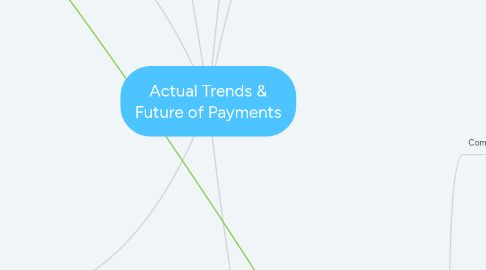
1. Security
1.1. Cybersecurity
1.2. Physical security & Biometric
1.2.1. Fingerprints
1.2.2. Facial recognition
1.2.3. Iris
1.2.4. Heartbeat analysis
1.2.5. Vein mapping
1.3. Safety & Blockchain
1.3.1. Increased transaction traceability
1.3.2. Reduced accounting reconciliation & compliance costs
1.3.3. It's here!
1.3.3.1. UX & rewards application: Amex loyalty program
1.3.3.2. International Transfer application: Ripple and Banco Santander
2. UX
2.1. Data exploration
2.1.1. Spending review
2.1.2. Wealth management
2.1.3. Restructured rewards
2.2. Daily-usages
2.2.1. 3rd parties app
2.2.1.1. Transport booking
2.2.1.2. Ordering meal
2.2.1.3. Managing appointments
2.2.2. Loyalty systems
2.2.2.1. Card-linked offers
2.2.2.2. Coupons
2.2.3. Gifts
3. Upcoming trends
3.1. Cryptocurrencies
3.1.1. Pros
3.1.1.1. Fintech is moving on
3.1.1.1.1. Bravo
3.1.1.1.2. Crypterium
3.1.1.1.3. Circle
3.1.1.1.4. Square
3.1.1.1.5. Revolut
3.1.1.2. Traditional company shift
3.1.1.2.1. Swift Stablecoins' plan for cross-border transfers
3.1.2. Cons
3.1.2.1. Price volatility
3.1.2.2. Slow transaction time
3.1.2.3. High transaction fee
3.2. New credit forms
3.2.1. Alternative credit scoring
3.2.2. P2P loans
3.2.3. Micro lending
3.3. Next frontier?
3.3.1. AR?
3.3.1.1. Dematerializing your wealth manager meetings?
3.3.2. IoT?
3.3.2.1. Accessing your bank through all devices?
3.3.2.2. Follow-me-drones acting as today's smartphone?
4. To dig in
4.1. Companies
4.1.1. Gemalto & Loyalty cards
4.1.1.1. 3 billion loyalty cards might been provisioned to mobile applications by 2020
4.1.2. Bravo & Blockchain/Cryptocurrency
4.1.2.1. Integrating Blockchain Technology & Cryptocurrency payment at the start
4.1.3. Alipay & UX
4.1.3.1. Core functionalities
4.1.3.1.1. Offline payment with Q code
4.1.3.1.2. Money transfer
4.1.3.1.3. Digital currencies
4.1.3.1.4. Gift / Red packets
4.1.3.1.5. Wealth management
4.1.3.2. 3rd parties app
4.1.3.2.1. Transport booking: bike, car, taxi, metro, bus, flights
4.1.3.2.2. Food delivery, Restaurant booking
4.1.3.2.3. Rewards: coupons, discounts
4.1.3.2.4. Other: Doctor's appointment, hotel booking
4.2. Consulting Agencies
4.2.1. McKinsey
4.2.1.1. Different culture and different customer habits
4.2.1.2. Payments would become a $2 trillion business by 2020
4.2.1.3. The 5 disruptive forces
4.2.2. Accenture: Future of payment trends
4.2.2.1. Gen Z rising: a need to share their payments and data
4.2.2.2. UX is the new gold: a need to use the easiest, safest, fastest, and most beneficial app
4.2.2.3. Mobile hits its groove: mobile banking app outpaced by digital wallet
4.2.2.4. Rewards revolution: consumers want more rewards and access them more easily
4.2.2.5. The network effect: future of payment might be a network of decentralize shareholders
4.2.2.6. Fintech and bank fusion: payment innovation is fueled by fintechs and banks partnerships
4.2.2.7. An arms race in code: IT costs are increasing due to the digital ecosystem
4.2.2.8. Payments everywhere: everyone can be a merchant and every device can be used
4.2.2.9. Fraudsters innovate too: criminals shift to new strategies by out-innovating the payments industry
4.2.2.10. RIP and replace required: real-rime payment is forcing traditional actors to review their business model
4.3. Experts
4.3.1. Before Babylon, Beyond Bitcoin - David G.W. Birch
4.4. European regulations
4.4.1. ISO20022 for real-time payment
4.4.2. GDPR for data management
4.4.3. PSD2D for new 3rd parties actors
4.4.3.1. PISP (Payment Initiation Service Provider)
4.4.3.2. AISP (Account Information Service Provider)
5. Seamless payment
5.1. Wearables
5.1.1. Biometric & wearables
5.2. NFC & Mobile Wallet
5.2.1. Partnership Nets / Pivo / Mash
5.2.2. Competitors
5.2.2.1. Google Wallet
5.2.2.2. Amazon payment
5.2.2.3. Square Cash
6. Real-time payment
6.1. Cross border transaction
6.1.1. Local apps
6.1.1.1. Lydia
6.1.1.2. Mobile Pay
6.1.1.3. Swish
6.1.1.4. Siirto
6.1.1.5. Pivo
6.1.2. B2B solutions
6.1.2.1. Ripple and Banco Santander partnership
6.2. Merchant payment
6.2.1. mPOS devices
6.2.1.1. Need to replace yesterday's payment infrastructure
6.2.2. Data exploration
6.2.2.1. Customers' data analysis
6.2.2.2. Insights for commercial strategy
